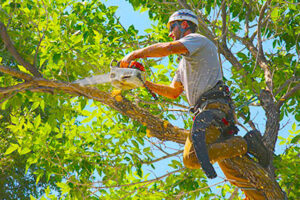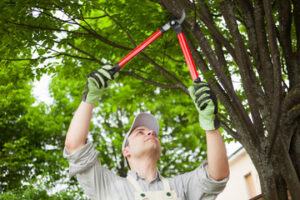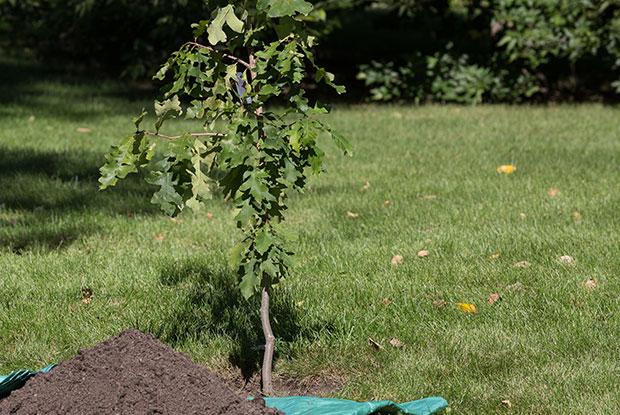Tree Service Irvine CA is an essential part of keeping your property looking its best. In addition to trimming, pruning, and fertilization services, they can also help reshape your property’s landscaping.
When choosing a Tree Service, ask for references from other local clients. This will give you a better understanding of their professionalism and customer satisfaction.

Like all plants, trees need to be cared for to remain healthy and vibrant. Proper care includes regular trimming, fertilization, pest control, and soil management to prevent diseases and promote growth. Healthy trees beautify landscapes, increase property values, purify the air, and conserve energy by shading the ground from summer heat and insulating roots against harsh winter temperatures.
Properly maintaining your trees will also promote the health and vitality of the underlying turfgrass. It is important to understand that all treatments applied to turfgrass can impact the appearance and vitality of the underlying trees in your landscape.
Every landscape has its unique set of conditions that must be addressed to ensure the plant’s long-term health. A professional arborist is trained to assess the individual needs of your landscape and select the best treatment options.
Many dangerous situations can occur when trimming or cutting a tree. A worker can be injured by a fall, struck by a falling limb, electrocuted by a power line, burned by spraying chemicals, or crushed by equipment or machinery.
Injury to landscaping and tree care workers is a significant public health concern. From 1992 through 2007, 1,285 workers died while performing tree care or landscaping tasks. Most of these deaths occurred in small establishments with ten or fewer workers. Employers should develop, implement, and enforce a comprehensive safety program that includes formal training in worksite hazards, tree trimming and pruning, electrical hazards, machine safety, safety along roadways, and first aid and cardiopulmonary resuscitation.
Tree service companies provide services such as trimming and pruning, planting and caring for young trees, insect pest control, and removing dead or diseased trees. They can also help with site, soil, and environmental problems. It is important to choose a tree company with experience and training and a solid track record of customer satisfaction. In addition, they should be insured in case of any accidents or injuries on the job site. Workers should always follow manufacturer instructions, wear personal protective equipment when handling hazardous materials, and avoid climbing or aerial access during wet, icy, or windy weather.
A professional tree pruning and removal service will help prevent injuries or accidents in the work area. This is because the professionals are experts in these tasks and have all the tools necessary to do them efficiently without any risks or hazards. They will also be able to save you the time that you would have spent trying to do it yourself and instead focus on other things.
Some of the most common injuries for tree care workers include cuts from chainsaws or axes, poison oak or poison ivy contact, and falls from elevation and struck by objects being handled, including whole trees and portions of rigged and dropping items. Some of these injuries are fatal.
Tree service workers must wear personal protective equipment, such as hard hats and gloves, and follow all manufacturer’s instructions when using the equipment. They should also be trained to recognize and avoid hazards, such as falling items, rigging failures, and weather-related hazards. They should also have an adequate supply of appropriate climbing and safety lines and properly fitting personal fall protection equipment.
In addition, ladders should be limited to the extent possible, and workers should only use them in a manner that does not pose an undue risk of falling or being struck by other items or persons. They should also be aware of any buried utilities in the work area, and all such underground lines should be marked before the start of work.
It is also a good idea to always provide tree care workers with water and encourage them to drink it when they feel thirsty. This will ensure they stay hydrated and can concentrate better on their jobs. They should be encouraged to wear light-colored clothing to minimize heat absorption and be supplied with sunscreen with a high SPF rating to protect them from sunburn. They should also be provided with a tool to check the temperature in the work area and be given regular breaks from their activities.
If you have trees on your property, keeping them looking their best is important. Tree services can help you achieve this by trimming them and removing dead branches or overgrown limbs. This can make your property look better and prevent injury or illness if a branch falls on someone. The professionals have the experience and expertise to trim or remove trees without damaging property or injuring people. They can also advise on how to care for your trees to help them grow better.
Keeping your trees healthy can also be beneficial for the environment. Trees are important for air quality and reducing erosion in areas with high rainfall or flooding. They can also protect homes from the elements by blocking wind and providing shade. Trees can also increase the value of your home. Hiring a professional tree service can keep your trees healthy and beautiful so they can continue to add value to your property.
A professional tree service company will be able to identify any issues with your trees and take steps to prevent them from getting worse. This can save you thousands of dollars in repair costs down the road. In addition, a professional will be able to work safely and efficiently with specialized equipment like bucket trucks, chainsaws, and rigging gear. They can also diagnose problems and recommend the best treatment options for your trees. If you want to hire a professional tree service company, ask for references and check their credentials before making any decisions.
Trees are not just beautiful; they add value to your property. Still, they also provide various benefits, including shade, oxygen production, soil stabilization, water conservation, and wildlife habitat, and they even help reduce energy costs through air pollution absorption. However, these benefits can only be realized when your trees are healthy and well-maintained. On the other hand, a dying or dead tree can be a liability and detract from the property value of your home or commercial building. In addition, a tree that is too close to your home can cause foundation damage and structural issues that could be very expensive to repair.
Planting and maintaining trees is one of the most effective ways to increase property value. It’s a good idea to consult with an arborist before you plant any trees on your property, as they can recommend the best location for them based on soil conditions, climate changes, and other factors. They can also provide industry-leading tree care to promote their health and beauty, ensuring they will add value to your property for years.
While planting and maintaining trees can increase your property value, there are times when removing them is necessary. This may be due to various reasons, from being infected or dying to being located in the wrong place and posing a risk to your home. In these situations, Tree Service can increase or decrease your property value depending on how the work is completed.
The profitability of your Tree Services company can be significantly improved by optimizing your processes and utilizing tools that help improve your business efficiency. This can mean better use of equipment, lower overhead expenses, and more reliable scheduling and labor. In addition, by implementing the right software, you can track the results of your services and identify areas for improvement.
A professional Tree Service provider can help you maximize the value of your property by providing expert tree maintenance, pruning, and removal services. They can ensure that your trees are thriving and looking their best, and they can assist you in making any other improvements to your landscaping to improve the overall curb appeal of your property.

